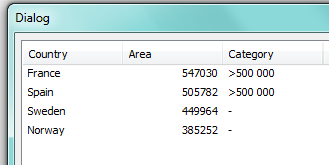Unlock a world of possibilities! Login now and discover the exclusive benefits awaiting you.
- Qlik Community
- :
- All Forums
- :
- QlikView App Dev
- :
- Re: resident load with examples?
- Subscribe to RSS Feed
- Mark Topic as New
- Mark Topic as Read
- Float this Topic for Current User
- Bookmark
- Subscribe
- Mute
- Printer Friendly Page
- Mark as New
- Bookmark
- Subscribe
- Mute
- Subscribe to RSS Feed
- Permalink
- Report Inappropriate Content
resident load with examples?
resident load with examples?
- Tags:
- new_to_qlikview
- Mark as New
- Bookmark
- Subscribe
- Mute
- Subscribe to RSS Feed
- Permalink
- Report Inappropriate Content
- Mark as New
- Bookmark
- Subscribe
- Mute
- Subscribe to RSS Feed
- Permalink
- Report Inappropriate Content
Resident is word means from RAM. Suppose if we get the table from source example SalesRep.we saved locally in qlikview with name SalesRep.then we want to use it again then instead connecting source and getting the fields we use resident load like below.
for example:
Resident Load:
Temp:
LOAD
*
FROM Data;
Temp1:
LOAD
*
FROM Temp;
Temp2:
LOAD
*
FROM Temp;
regards
Mahesh T.
- Mark as New
- Bookmark
- Subscribe
- Mute
- Subscribe to RSS Feed
- Permalink
- Report Inappropriate Content
- Mark as New
- Bookmark
- Subscribe
- Mute
- Subscribe to RSS Feed
- Permalink
- Report Inappropriate Content
resident pag. 14 and a lot of other load
- Mark as New
- Bookmark
- Subscribe
- Mute
- Subscribe to RSS Feed
- Permalink
- Report Inappropriate Content
Syntax:
load [ distinct ] *fieldlist
[( from file [ format-spec ] |
from_fieldfield [format-spec]
resident table-label )]
[ where criterion ] | while criterion ]
[ group_by fieldlist ]
[order_by field [ sortorder ] { , field [ sortorder ] } ]
If you are not able to follow the syntax try the example below,
Example:
The resident table is useful when we want to split a table into multiple cubes, say for example when we want to create table X with specific year using the main table A and create another table Y with specific division/department using the same main table A it is possible using RESIDENT Table concept.
Table: A | ||
Division | Department | Year |
1 | A | 2010 |
2 | B | 2011 |
3 | C | 2010 |
4 | D | 2012 |
5 | E | 2010 |
X:
Load * from A Where year=2010;
Output:
Table: X | ||
Division | Department | Year |
1 | A | 2010 |
3 | C | 2010 |
5 | E | 2010 |
Y:
Load * from A Where Div in ('1','3');
Output:
Table: Y | ||
Division | Department | Year |
1 | A | 2010 |
3 | C | 2010 |
- Mark as New
- Bookmark
- Subscribe
- Mute
- Subscribe to RSS Feed
- Permalink
- Report Inappropriate Content
Here is an example on resident load, i.e. you load from an already loaded table. Below we first create the table Countries. Here Inline is used, but it might as well have been loaded from a database or spreadsheet. In the second statement the RESIDENT syntax is used to load values from the Countries table to create a new field for countries larger than 500 000 km2. The tables are joined. Hope this helps you on the way.
Countries:
LOAD * INLINE [
Country, Area
France, 547030
Spain, 505782
Sweden, 449964
Norway, 385252 ];
Join(Countries) Load
Country,
Area,
'>500 000' as Category
Resident Countries
Where Area>500000;
Result:

- Mark as New
- Bookmark
- Subscribe
- Mute
- Subscribe to RSS Feed
- Permalink
- Report Inappropriate Content
Hi Manoj,
can you please close the thread if you are fine with answers posted so that it will be helpful to other users as well.
regards
Mahesh T
- Mark as New
- Bookmark
- Subscribe
- Mute
- Subscribe to RSS Feed
- Permalink
- Report Inappropriate Content
Let me also try... ![]()
Temp:
Load * Inline
[
Customer, Sales
A, 100
B, 200
A, 300
C, 150
D, 200
B, 140
E, 400
C, 340
];
//The above table is showing only two columns but it should have some dates, months or years but it is not necessary //for this example, so I haven't mentioned.
Final:
Load
Customer,
SUM(Sales) as [Total Sales]
Resident Temp
Group By Customer;
Drop Table Temp;
//The 2nd table is calculating Total Sales per customer using Resident Load of First Table.
//We don't need Temp table, so we can remove it now.
Hope this help.